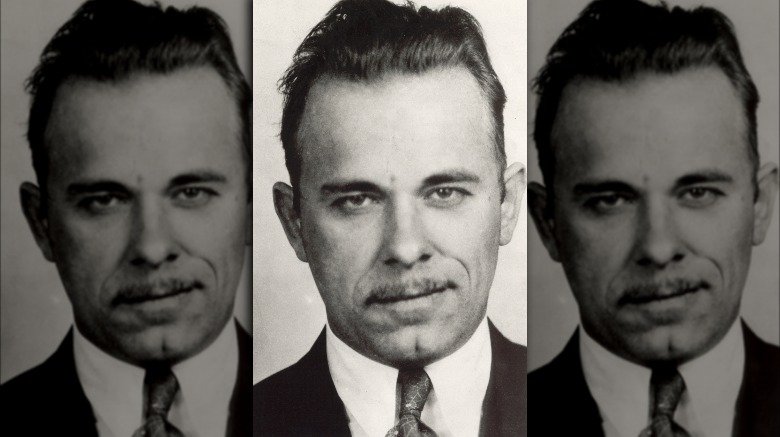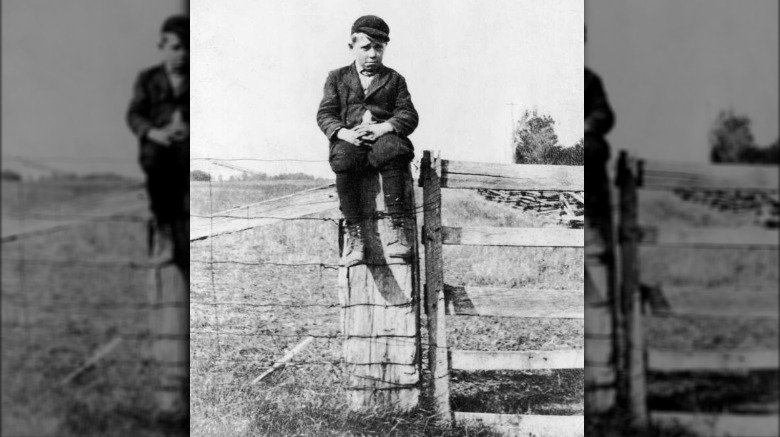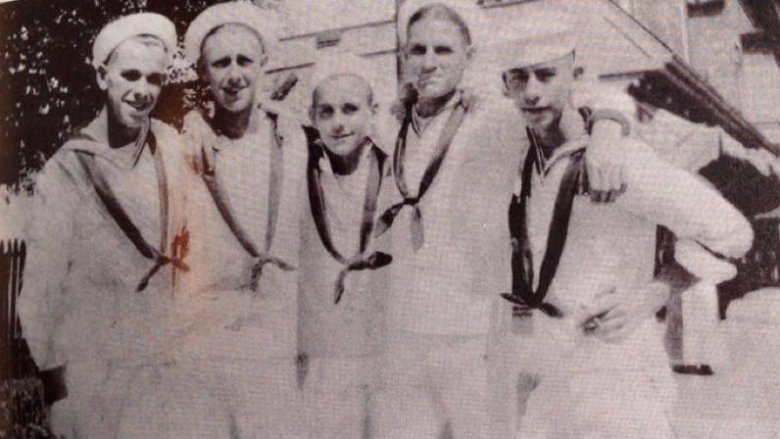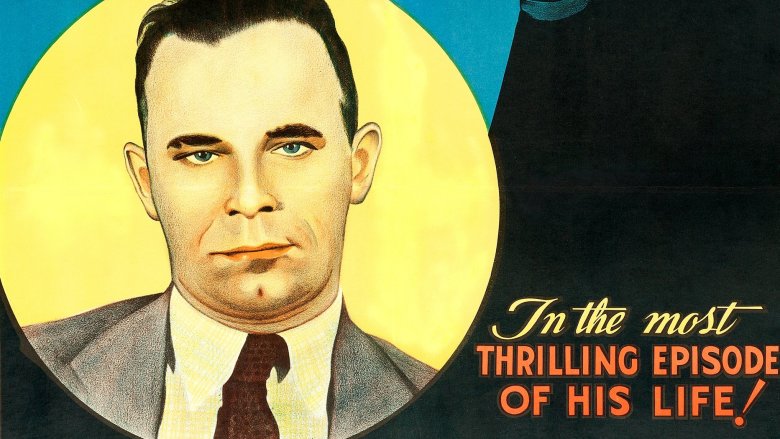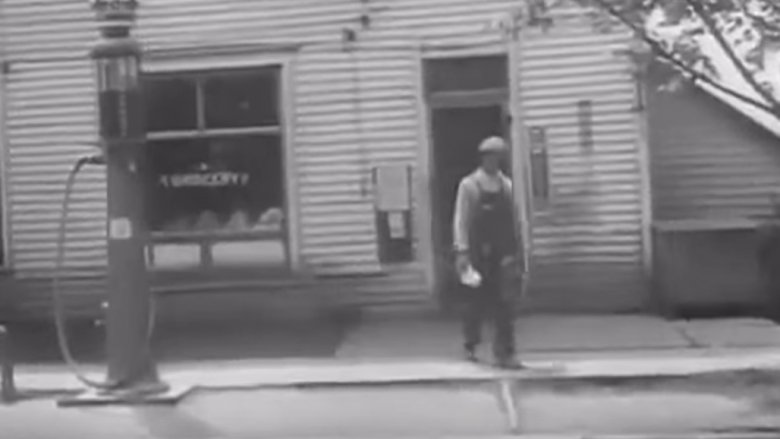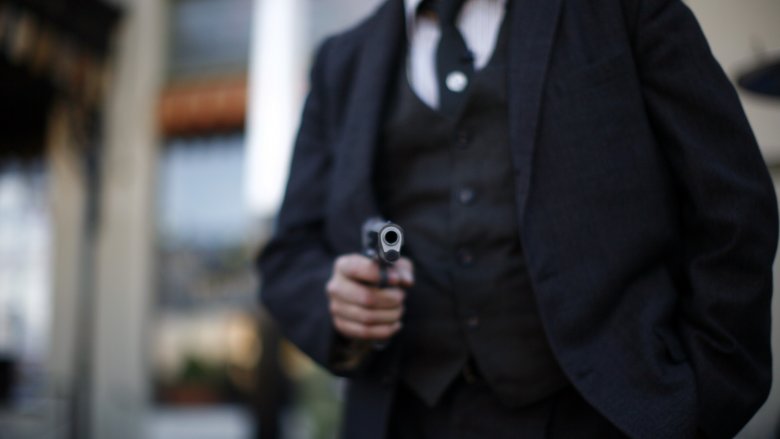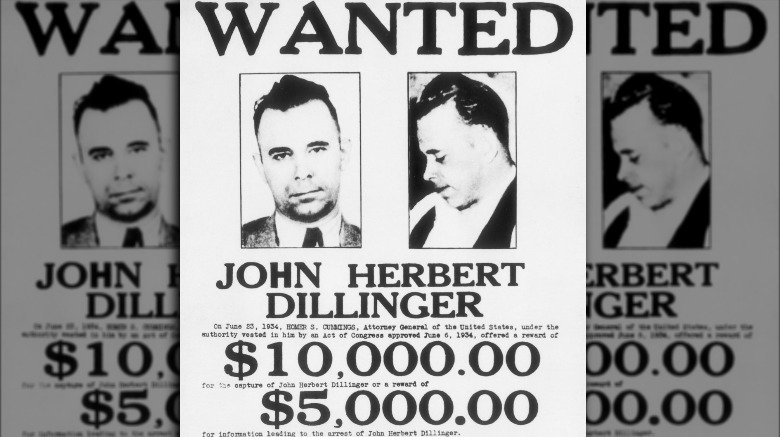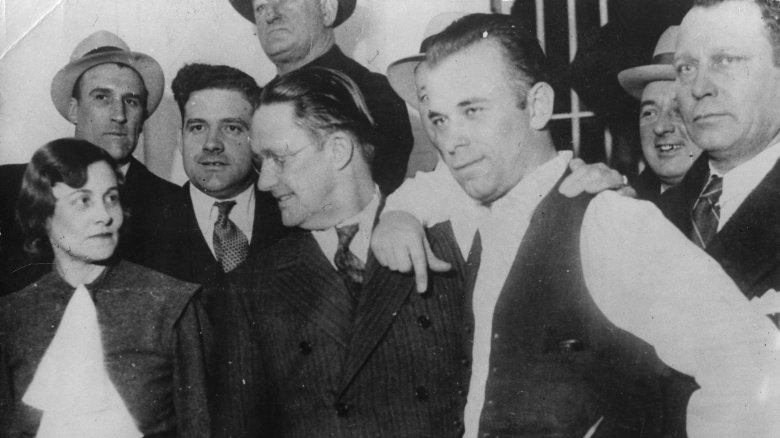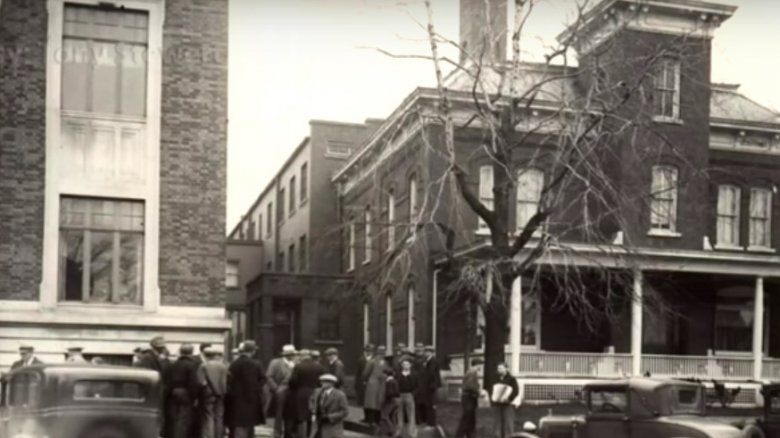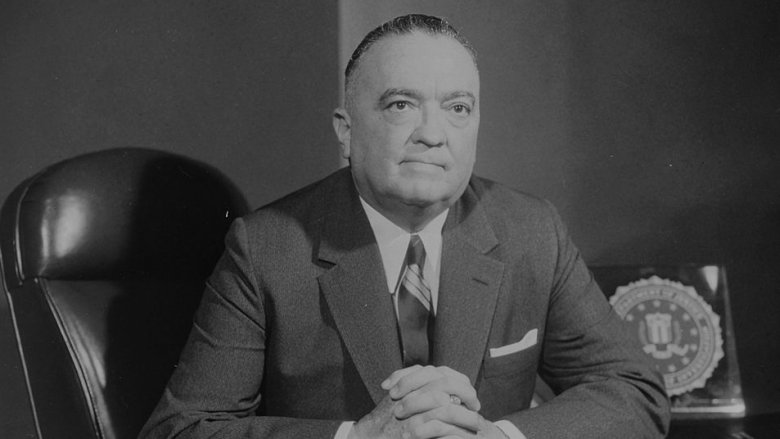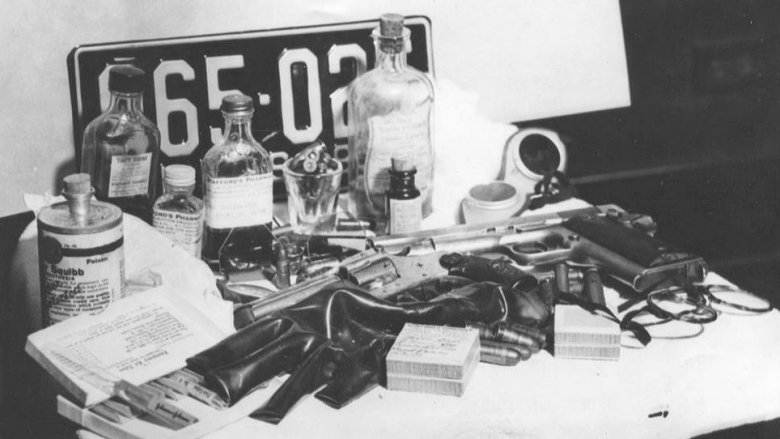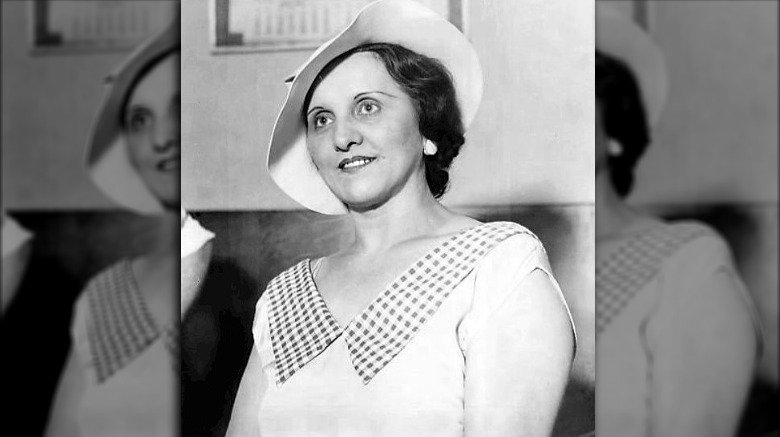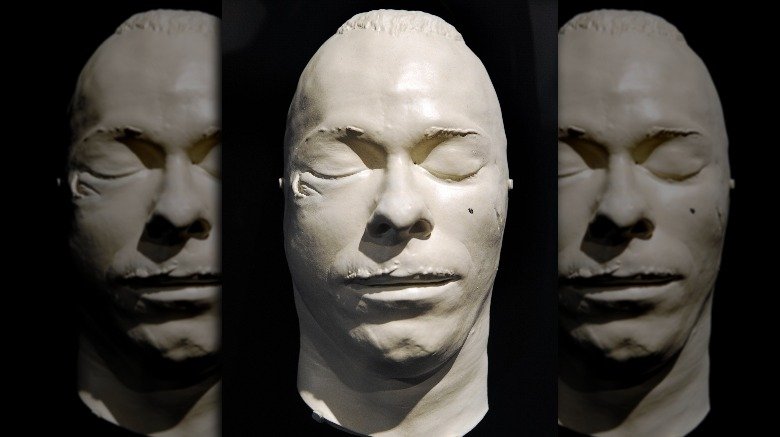The Untold Truth Of John Dillinger
When the infamous bank robber and outlaw John Dillinger was buried in an Indiana cemetery, his relatives put him under 3 feet of concrete and scrap metal. Now, there are only really a few reasons you might want to bury your relative in that way. Maybe you think he'd be a target for grave robbers and trophy-seekers. Or maybe you think he might be a vampire. Or maybe you don't want anyone to find out that it's not really him in that grave.
So which one was it? For decades, history has accepted the first reason — Dillinger was an anti-hero, a charismatic sort of Robin Hood figure who captivated the media and captured the public's imagination. So there were probably at least a few sick people out there who would have dug him up for a lock of hair or the ring on his decomposing finger.
Now history kind of seems to be changing its mind ... or at least Dillinger's living relatives are. It's not that they think he might be a vampire (though that would be grand); it's that they think it might not be him in the grave. So what's the deal with John Dillinger, anyway? How did he become such a legend? And why do people actually care who's buried under that slab of concrete?
Surprise … John Dillinger had a troubled childhood
Not every outlaw, bank robber, and villain comes from a broken home, but it's never especially surprising when you find out that someone who misbehaves as an adult also misbehaved as a child. And misbehaving children often have trauma in their history, or at the very least lack the sort of adult guidance that can put them on more of a non-outlawy path.
John Dillinger lost his mom when he was very small — she died from a stroke when he was just 4 years old. According to History, his dad was an inconsistent disciplinarian who would beat him up and lock him in the house, but then let him roam around the neighborhood at night. Shockingly, kid Dillinger developed a rebellious streak. He became the leader of a street gang called "The Dirty Dozen," which mostly just ran around the neighborhood pranking people and stealing things.
Despite the pranks and petty theft, most of Dillinger's former neighbors would later say he was a cheerful and likable kid. Nothing like rose-colored "I once knew that celebrity" glasses, right? The truth was probably much less sunny, though. There were also reports of teenaged antics that included "malicious behavior," so all was clearly not right with Dillinger even when he was a youth. By 16, John Dillinger had dropped out of school. He held down a job but would regularly visit prostitutes, drink, and get into fights, and really it was pretty much downhill from there.
John Dillinger was a military deserter
John Dillinger was clearly fond of morally questionable antics, but at some point, for some reason, he decided he'd be a fine candidate for the military. What's that? Actually it was because he was evading arrest and figured the Navy sounded better than the inside of a cell? Makes perfect sense.
In 1923 he joined the Navy and was assigned to the USS Utah as a Fireman 3rd Class. According to Medic in the Green Time, his job was shoveling coal into the ship's burners, which sounds pretty sucky no matter who you are, but for a guy like John Dillinger (far left, above) it was sucky to the point where he figured he really shouldn't have to do it. So not long after signing up, he went AWOL. Well, the military is not super cool with people going AWOL, so when he came back they threw him in the brig and gave him bread and water for 10 days.
After he emerged from the brig, John Dillinger was humbled and ready to be a proper Navy man. Hahaha just kidding, no, he waited until the ship docked in Boston and then he was outta there. His superiors waited two weeks for him to come back (that bread and water was beckoning, after all) and then listed him as a deserter. He was finally given a "undesirable discharge" in 1925 while he was serving time at the Indiana State Reformatory.
John Dillinger's wife divorced him during his first incarceration
After he tried and failed at the military thing, John Dillinger tried and failed at the marriage thing. According to History, in the spring of 1924 he met Beryl Ethel Hovious and decided to abandon his life of crime and become a solid citizen. Well, he did get married, but he definitely did not become a solid citizen. It seems like he did try, though, at least for a little while.
John Dillinger and his bride had no income, so the couple moved into the house on Dillinger's father's farm. Then, just a few weeks after the wedding, he got caught stealing chickens, and his dad had to pull strings to keep him out of jail. The incident didn't really improve the already-not-very-strong father-son bond the two Dillinger men enjoyed, and the couple ended up moving in with Beryl's parents. Finally, Dillinger got a job in an upholstery shop and joined a baseball team, which seemed like a positive step forward, except that's how he met his first real partner in crime, Edgar Singleton, and ended up in the Indiana State Reformatory. (We'll get to all that in a second.)
Beryl visited him there for a few years, and Dillinger sent her frequent letters of love and devotion, but she eventually got restless and by 1929 they divorced. Dillinger would later say she had broken his heart.
John Dillinger's first real crime was a foiled stick-up
The crime that got John Dillinger a 10- to 20-year prison sentence in the Indiana State Reformatory was not a bank robbery or even a manslaughter charge — no, it was a foiled stick-up. And it was Edgar Singleton, the guy he met while playing on the baseball team, who talked him into committing the crime. According to History, the duo planned to rob an elderly grocer at gunpoint — Dillinger would confront the old man while Singleton waited in an alley with a getaway car. But things didn't go the way they were supposed to. The grocer fought back, the gun went off, and Dillinger fled. And then, because his day wasn't already going badly enough, when Dillinger arrived in the alley there was no sign of Singleton or the getaway car.
Dillinger and Singleton were both caught by the police, but Singleton had a lawyer and Dillinger did not. Also, John Dillinger's father got some terrible legal advice from the local prosecutor, who promised the courts would be lenient if his son would just plead guilty.
John Dillinger took the prosecutor's advice and the courts went "hahaha sucker" and gave him 10 to 20 years. Meanwhile, Singleton served two years of his four-year sentence because he did have a lawyer who knew better than to believe empty promises.
John Dillinger planned his early robberies while he was in jail
Once incarcerated, John Dillinger didn't exactly decide to become a model prisoner so he could qualify for early release. However, he did work in the prison shirt factory as a seamster and was so awesome at it that he used to fill his own quota and then fill some of the other seamsters' quotas, too, which made him popular with fellow prisoners if not especially upstanding. According to History, he also tried to break out a few times, so there's that.
By the time Beryl divorced him, Dillinger was already a deeply bitter man. During his time at Indiana State Reformatory, he made friends with fellow convicts who taught him the fine art of bank robbery and got his feet planted firmly on the road to never being able to do anything else with his life except steal from other people and avoid the police. Dillinger's sentence was shorter than his new friends' sentences, so he was tasked with carrying out a series of fundraising robberies that would give them the money they needed to bribe their guards and facilitate their escape.
Their lucky break came when John Dillinger was granted early parole so he could visit his gravely ill stepmother. She died before he could return home, but that wasn't really the point, was it? To be fair, though, Dillinger reportedly loved his stepmother, so her death likely only added to his bitterness.
John Dillinger was only ever charged with one murder
You probably wouldn't be surprised to hear that during his long criminal career, John Dillinger was charged with multiple murders. However, you won't hear that because it's not actually true. According to the Indiana Law Enforcement Memorial, Dillinger was only ever charged with one murder — that of 43-year-old patrolman William Patrick O'Malley.
O'Malley was one of the officers who responded to a robbery at the First National Bank of East Chicago on January 15, 1934. He arrived just as John Dillinger and his gang were fleeing the scene. The two men exchanged gunfire, but Dillinger was wearing a bullet-resistant vest so he escaped unharmed. O'Malley wasn't so lucky.
O'Malley's descendants say his body had 18 bullet holes in it. It was the first Dillinger Gang killing of a law enforcement officer and the only death ever attributed to John Dillinger himself. Dillinger was eventually extradited to Indiana to face changes for the murder. He escaped, though, and spent most of the rest of his life on the run, so he was never actually convicted of the crime.
The public loved John Dillinger
John Dillinger was a bad guy. There's really not much doubt about that. Yet for some reason, the public loved him (much like they loved Bonnie and Clyde) and sometimes even seemed to think of him as a Robin Hood sort of figure, even though there's not really any evidence that he was ever especially generous to the poor. To understand the public fascination with John Dillinger, though, you really only have to look at the times in which he lived.
After the death of Patrick O'Malley, Dillinger was named "Public Enemy Number One." That title put him in the spotlight — a spotlight he also shared with the many tangible misfortunes of the Great Depression. People everywhere were suffering, and a lot of them blamed the banks for their troubles. So Dillinger wasn't just a criminal, he was a guy who was fighting back against the institutions that had robbed the common people.
It didn't hurt that he was also charismatic as heck. Every encounter with the police seemed to come with a great one-liner that would further endear him to the media and the people. According to JohnDillinger.com, when police shackled him to his seat on an airplane, he famously said, "Guys, I don't jump from these things." No wonder the public thought he was adorable.
John Dillinger broke out of jail with a fake gun
No antihero would be quite as antiheroic without a couple decent jailbreaks, and John Dillinger didn't just have the jailbreaks, he had jailbreaks that were cleverly planned and executed and even included supervillain-style witty banter.
John Dillinger's most famous jailbreak was his last one. According to the New York Daily News, in the late winter of 1934 Dillinger was transported from Arizona to the "escape proof" Lake County Jail in Indiana, which sounds a bit like the "unsinkable" Titanic, but whatever. Anyway, Dillinger didn't seem especially intimidated by Lake County's reputation, famously declaring that "a jail is like a nut with a worm in it." And it wasn't just bravado, either — on March 3, 1934, he really did escape, and he did it with a fake gun.
Where did he get the fake gun? He carved it himself, possibly from the leg of something like a washboard — and then he blackened it with something like shoe polish and waved it around intimidatingly until the guards let him out. Then he waved it around some more until every employee was locked away in a closet or cell. Finally, he stole a couple real guns and a car and forced a garage employee to drive him away while singing "Git along, lil' doggie."
Incidentally, that fake gun is now so iconic that there are at least three versions of it, and no one's quite sure which one is genuine.
John Dillinger sort of reformed the FBI
John Dillinger's break from the Lake County Jail turned out to be his fatal mistake, and it wasn't because he used a fake gun or stole machine guns or kidnapped a garage employee — it was because he stole a sheriff's car and used it to cross the border between Indiana and Illinois. That was a violation of the National Motor Vehicle Theft Act and a federal offense, which meant the FBI was now involved in the effort to bring him to justice.
John Dillinger was kind of like the FBI's big break — before his infamous crime spree, the bureau was suffering from a credibility problem. They were expected to work with local police, which was as embarrassing as it was inefficient. When Dillinger rose to infamy, J. Edgar Hoover was trying to reform the FBI, and one of his latest strategies was assigning "special agents" to high-profile cases like Dillinger's. In many ways, Hoover used Dillinger's infamy to elevate the FBI into a bureau of heroes. "[When] the FBI transformed John Dillinger into "Public Enemy #1" ... what does that turn J. Edgar into?" crime historian Paul Maccabee told South Dakota Public Broadcasting. "It turns him into Public Friend #1."
John Dillinger had radical plastic surgery in hopes people would stop recognizing him
John Dillinger loved the spotlight, but unfortunately for him, being a highly recognizable celebrity outlaw was not really that compatible with evading the police. According to Crime Museum, Dillinger's face became so well known that he had a hard time laying low. In Mercer, Wisconsin, Dillinger holed up at the Little Bohemia Lodge with some of his criminal cohorts, but other residents of the inn recognized him and called the police. He barely escaped, and at that point concluded that he would need to change his appearance if he was going to avoid arrest indefinitely.
Dillinger dyed his hair and grew a mustache, but that really wasn't enough so he enlisted the help of "underworld plastic surgeons" Wilhelm Loeser and Harold Bernard Cassidy and had his entire face changed. He also burned off his fingerprints with acid, which might have been a good idea except he was probably the only bank robber in America who left burned-off fingerprints behind, so it really seems like maybe an only marginally effective strategy in exchange for some serious fingertip pain. And unless he was planning to never rob a bank again (haha) or to never get captured again or to always wear a mask while committing crime, well, it seems like the plastic surgery was also a temporary solution. But we'll never know because Dillinger was finally foiled not long after the plastic surgery that he'd hoped would save his life.
John Dillinger was betrayed by a friend
John Dillinger must have been feeling pretty good about his new face and his supposed anonymity because on the night of July 22, 1934, he decided to go to a movie with friends Polly Hamilton and Anna Sage. "Friends" isn't really the right word, though. Anna Sage, as it turned out, was not his friend — she had just tipped off the FBI about his whereabouts.
According to the FBI, Sage was a brothel madam who was about to be deported for being in the country illegally, so it wasn't just the $10,000 reward she was after. She agreed to provide information about Dillinger in exchange for a stop to the deportation proceedings. She told agents when and where they could find the infamous outlaw, and when the film ended, the FBI was waiting outside.
Dillinger pretty quickly recognized the sting operation and fled into an alley, where he was shot by agents. The bullet that killed him entered the back of his neck and severed his spinal cord before continuing its journey to his brain. It exited just under his right eye. And so ended John Dillinger's celebrity crime spree. His total takings: About $500,000, which was roughly a quarter of what the FBI spent on its effort to bring him to justice.
Rest in peace — for a while, anyway
John Dillinger's body was put on public display at the Cook County morgue, and thousands of people came to see it. A Wild West show even offered Dillinger's father $5,000 for his son's body, and yes, they did plan to put it in their icky, icky, Wild West exhibition. So really, the decision to bury the body under 3 feet of concrete was a practical one — Dillinger's family had no reason to think that the public's appetite for morbid spectacle would go away once he was in the ground.
But as the years passed, Dillinger's living relatives stopped caring so much about the peaceful slumber of his mortal remains. According to Fox Business, in July 2019 they applied for a permit to exhume his body. "I have been presented with evidence that demonstrates that the individual [in the grave] ... may not in fact have been my uncle, John H. Dillinger," his niece and nephew wrote in separate affidavits. It's not the first time the theory has been raised — in fact in 1965 the Indianapolis News received a letter from a man claiming to be John Dillinger.
Of course there's also the part where the family may or may not be profiting off the History Channel documentary that will show the entire morbid affair to a prime-time television audience, but whatever. Did Dillinger really die in that alley? We'll know the answer in September, if the exhumation goes forward as planned.
